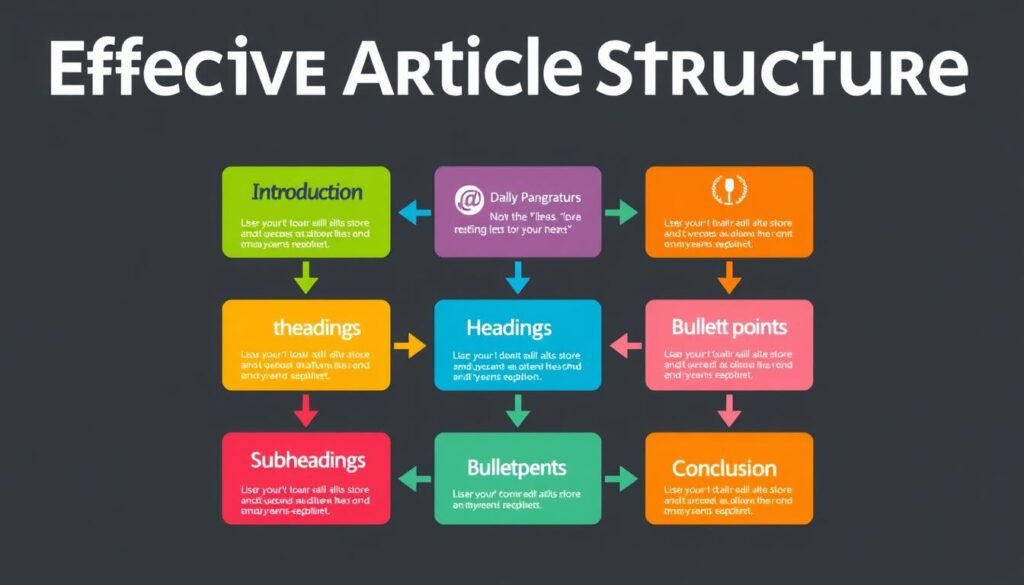
How to Create Effective Articles in 2023
Creating effective content is crucial in the rapidly evolving digital landscape of 2023. As content creators, we face numerous challenges in producing efficient and engaging articles that capture our audience’s attention. Mastering the art of effective article writing can have numerous benefits, including increased reader engagement and improved brand visibility. In this article, we will explore the key elements of creating effective articles, from understanding our target audience to crafting compelling titles and utilizing visual elements.

Our goal is to provide readers with a clear roadmap for creating efficient and effective content that resonates with their audience. By the end of this article, readers will have a comprehensive understanding of the key principles and strategies for producing high-quality articles that drive results.
Introduction to Effective Article Writing
Throughout this article, we will delve into the importance of creating effective content, identifying our target audience, and crafting compelling titles and introductions. We will also explore the role of visual elements, research, and data in enhancing our articles and providing value to our readers.
Key Takeaways
- Creating effective content is crucial for capturing audience attention and driving results
- Understanding our target audience is essential for producing efficient and engaging articles
- Crafting compelling titles and introductions can significantly improve reader engagement
- Utilizing visual elements and research can enhance our articles and provide value to our readers
- Mastering the art of effective article writing can improve brand visibility and increase reader loyalty
- Producing high-quality, efficient content can help content creators stand out in a rapidly evolving digital landscape
Understanding the Importance of Effective Content
Creating successful content is crucial in today’s digital landscape. It plays a vital role in establishing a brand’s online presence and engaging with the target audience. Effective content is impactful, resonating with readers and leaving a lasting impression. This, in turn, can lead to increased engagement, improved SEO rankings, and enhanced brand authority.
When it comes to content creation, many individuals and businesses strive to produce high-quality, engaging articles. However, some common misconceptions can hinder the process. For instance, many believe that creating effective content is solely about keyword optimization, when in fact, it’s about crafting a compelling narrative that resonates with the audience.
To create successful and impactful content, it’s essential to understand the key benefits of effective articles. Some of these benefits include:
- Increased engagement and conversion rates
- Improved SEO rankings and online visibility
- Enhanced brand authority and credibility
By focusing on creating high-quality, engaging content, individuals and businesses can establish a strong online presence, build trust with their audience, and ultimately drive success.
Identifying Your Target Audience
Understanding who your target audience is can be advantageous for creating content that resonates with them. It allows you to tailor your message, tone, and style to meet their specific needs and interests, making your content more productive and effective. To start, you need to research your audience’s preferences, which can include their demographics, interests, and behaviors.
Researching audience preferences involves gathering data about your target audience. This can be done through surveys, focus groups, and online analytics tools. By analyzing this data, you can create detailed audience personas that outline their characteristics, needs, and pain points. For example, you can create a persona for a young professional who is interested in technology and innovation, and tailor your content to meet their specific needs and interests.
Researching Audience Preferences
Some ways to research audience preferences include:
- Conducting surveys and focus groups to gather feedback and opinions
- Analyzing online analytics data to understand audience behavior and demographics
- Creating social media polls to gauge audience interest and engagement
Creating Audience Personas
Once you have gathered data about your target audience, you can create detailed audience personas. These personas should include information such as:
| Characteristic | Description |
|---|---|
| Demographics | Age, gender, location, occupation |
| Interests | Hobbies, passions, topics of interest |
| Needs | Pain points, challenges, goals |
By creating audience personas and tailoring your content to meet their specific needs and interests, you can create content that is more engaging, relevant, and productive. This can help you build a loyal audience and achieve your content marketing goals.
Crafting a Compelling Title
A well-crafted title can make a significant difference in the success of an article, as it can be both profitable in terms of attracting traffic and beneficial for overall content performance. To create a compelling title, it’s essential to understand the importance of capturing the reader’s attention and driving click-throughs.
When writing a title, consider using actionable words and phrases that create a sense of urgency, such as “limited time offer” or “exclusive deal.” This can help increase the title’s effectiveness and make it more profitable. Additionally, incorporating relevant keywords can be beneficial for search engine optimization (SEO) purposes, as it can improve the article’s visibility and ranking.
For more information on crafting effective titles, visit title examples and learn how to create titles that resonate with your audience and drive results. Some key tips for writing attention-grabbing titles include:
- Keeping it concise and to the point
- Using relevant keywords and phrases
- Creating a sense of urgency or curiosity
By following these tips and testing your titles for effectiveness, you can create a compelling title that drives traffic and engagement, making it a profitable and beneficial investment for your content.
Structuring Your Article Effectively
To create an effective article, it’s essential to have a clear and logical structure. This helps readers to follow your argument and understand the information you’re presenting. A well-structured article is also more efficient to read, as it guides the reader through the content in a logical and coherent way.
When planning your article, consider using a clear outline to organize your thoughts and ideas. This will help you to create a cohesive and efficient structure, making it easier for readers to follow. You can find more information on creating effective time management strategies to achieve more with less stress in a fast-paced world by visiting time management resources.

Best practices for paragraph structure include using short, concise paragraphs that focus on one main idea. This makes it easier for readers to understand and digest the information. Using headings and subheadings can also help to break up the content and create a clear hierarchy of information. Effective use of headings can improve the readability and SEO of your article, making it more efficient for readers to find and understand the information they need.
Some key considerations for structuring your article include:
- Creating a clear and logical outline
- Using efficient paragraph structure
- Utilizing headings and subheadings to improve readability and SEO
By following these best practices, you can create an effective and efficient article that engages and informs your readers.
Writing an Engaging Introduction
To craft a successful article, it’s essential to start with a strong introduction that captures the reader’s attention. A well-written introduction sets the tone for the entire piece and can make a significant difference in keeping readers engaged. An impactful introduction should provide a clear idea of what the article is about and what readers can expect to learn.
When writing an introduction, consider the following key elements:
- Start with a hook to grab the reader’s attention
- Provide background information or context
- Clearly state the purpose or thesis of the article
By incorporating these elements, you can create an introduction that is both successful and impactful, drawing readers in and encouraging them to continue reading.
Capturing Attention Quickly
To capture attention quickly, use a surprising statistic, a thought-provoking question, or a personal anecdote. This will help readers become invested in the article and more likely to continue reading. Remember, the goal of the introduction is to provide value right away, so make sure to include relevant information that sets the stage for the rest of the article.
Incorporating Valuable Research and Data
When creating effective articles, it’s essential to incorporate valuable research and data to support arguments and enhance credibility. This advantageous approach can make content more productive in terms of achieving its goals. By leveraging well-researched information, authors can establish trust with their audience and provide actionable insights.
To start, finding reliable sources is crucial. This involves vetting sources for credibility and accuracy. Some tips for finding reliable sources include:
- Utilizing academic journals and publications
- Consulting government reports and data
- Seeking out expert opinions and interviews
Once reliable sources are found, presenting data in a reader-friendly way is key. This can involve using visual aids like charts and graphs to break down complex information. By presenting data in an easily digestible format, authors can make their content more engaging and accessible to a wider audience.
Properly citing sources is also vital for maintaining credibility. This involves accurately referencing sources and providing clear attribution. By doing so, authors can demonstrate their commitment to accuracy and transparency, making their content more trustworthy and productive.

By incorporating valuable research and data, authors can create content that is both informative and engaging. This advantageous approach can help establish trust with the audience and provide actionable insights, making the content more productive in terms of achieving its goals.
| Research Tip | Description |
|---|---|
| Start with a clear question | Define the research question or topic to guide the search for reliable sources |
| Use multiple sources | Consult a variety of sources to ensure a well-rounded understanding of the topic |
| Evaluate sources critically | Assess the credibility and accuracy of sources to ensure reliability |
Utilizing Visual Elements
Visual elements play a crucial role in making articles more engaging and profitable. By incorporating images, graphics, and other visual aids, authors can break up large blocks of text and make their content more shareable. This approach is particularly beneficial for readers who are visual learners, as it helps them to better understand and retain information.
According to experts, using visual elements can increase reader engagement by up to 30%. This is because visuals can help to convey complex information in a more concise and easily digestible way. For example, a graph or chart can be used to illustrate data and trends, making it easier for readers to understand and analyze the information. To learn more about how to create effective content, visit Living Wisdom, a blog that provides practical tips for daily life improvement.
Some types of visual elements that can be used in articles include:
- Images
- Graphics
- Infographics
- Videos
These visual elements can be created using a variety of tools, such as Adobe Creative Cloud or Canva. By incorporating these elements into their articles, authors can make their content more engaging,profitable, andbeneficialfor their readers.
Overall, utilizing visual elements is a key aspect of creating effective and engaging articles. By incorporating these elements into their content, authors can increase reader engagement, improve information retention, and make their content more shareable.
Crafting a Strong Conclusion
To create an effective article, it’s essential to craft a conclusion that efficiently wraps up the main points and leaves a lasting impression on the reader. A strong conclusion should be concise, yet impactful, and motivate the reader to take action. This can be achieved by summarizing key points in a clear and efficient manner, using language that resonates with the target audience.
An efficient conclusion should also encourage reader action, whether it’s to visit a website, sign up for a newsletter, or share the article on social media. By including a call-to-action, you can increase engagement and drive results. Some effective ways to encourage reader action include:
- Providing a clear and direct call-to-action
- Offering incentives or rewards for taking action
- Using action-oriented language, such as “sign up now” or “learn more today”
Ultimately, a strong conclusion should leave a lasting impression on the reader, making them more likely to remember the article and take action. By crafting an effective and efficient conclusion, you can increase the impact of your article and achieve your goals.
| Characteristics of a Strong Conclusion | Description |
|---|---|
| Concise | Summarizes key points in a clear and efficient manner |
| Impactful | Leaves a lasting impression on the reader |
| Action-oriented | Encourages the reader to take action |
Promoting Your Effective Article
Now that you’ve crafted a compelling and informative article, it’s time to ensure it reaches the right audience. Leveraging social media strategies can be a powerful way to successfully amplify your content and drive engagement.
Start by sharing your article across relevant social media platforms, using appropriate hashtags and tagging influential figures or industry peers. Encourage your network to interact with the content by posing thought-provoking questions or inviting their perspectives. Engaging with your audience in the comments section can foster a sense of community and solidify your impactful presence.
Additionally, monitor the performance of your article using analytics tools. Closely track metrics such as page views, time spent on the article, and social sharing to gauge its effectiveness. Use these insights to refine your content strategy, experiment with different formats or topics, and continuously improve your future articles.
FAQ
What are the key benefits of creating effective articles?
The key benefits of creating effective articles include increased engagement, improved SEO rankings, enhanced brand authority, and better overall content performance. Effective articles can help businesses, bloggers, and content creators achieve their goals more efficiently and profitably.
How can I tailor my content to meet the specific needs of my target audience?
To tailor your content for your target audience, you should start by researching their preferences, creating detailed audience personas, and then crafting content that specifically addresses their interests and pain points. This will help ensure your articles are advantageous and productive for your readers.
What are some best practices for writing attention-grabbing titles?
Some best practices for writing attention-grabbing titles include using keywords strategically, creating a sense of curiosity, highlighting the key benefits for the reader, and testing different title variations to see what resonates best. A well-crafted title can be both profitable and beneficial for your content’s overall performance.
How can I effectively structure my articles to improve readability and engagement?
To structure your articles effectively, focus on creating a clear outline, using a logical paragraph structure, and incorporating headings and subheadings to guide the reader. These best practices can help you efficiently convey information and keep your readers engaged throughout the article.
What are some strategies for crafting an engaging introduction?
Strategies for crafting an engaging introduction include capturing attention quickly, setting the right tone for the article, and offering immediate value to the reader. A strong introduction can have a significant impact on the overall success and impressiveness of your content.
How can I incorporate valuable research and data to enhance the credibility of my articles?
To incorporate valuable research and data, start by finding reliable sources, present the information in a reader-friendly way, and properly cite your sources to maintain credibility. Balancing data with engaging narrative can make your content more advantageous and productive for your readers.
What types of visual elements should I consider using in my articles?
Consider incorporating a variety of visual elements, such as images, graphics, infographics, and videos, to enhance your articles. Visuals can improve reader engagement, information retention, and shareability, making your content more profitable and beneficial.
How can I create a strong conclusion that leaves a lasting impression?
To create a strong conclusion, focus on summarizing the key points effectively, encouraging the reader to take action, and leaving them with a memorable final impression. An efficient conclusion can reinforce the main message of your article and motivate the reader to engage further.
What strategies can I use to promote my effective articles and measure their performance?
To promote your effective articles, utilize social media strategies, engage with your audience post-publication, and measure article performance to identify areas for improvement. Continuous iteration and promotion are crucial for ensuring the long-term success and impact of your content.


